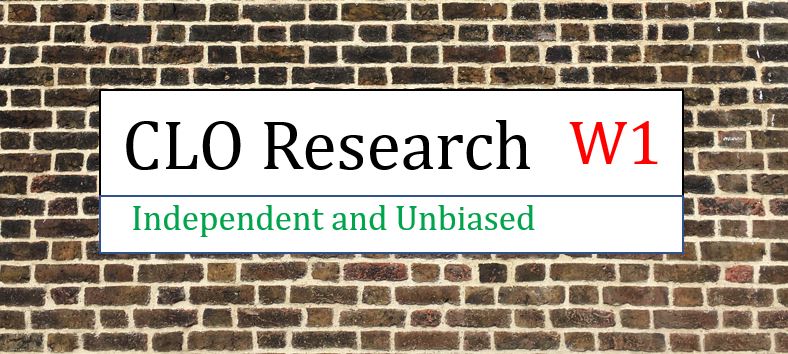Intelligent people make decisions based on opportunity costs.
—Charlie Munger
CCC/Caa – To Sell, Or Not To Sell, That Is The Question
It is probably not tenable to hold on to underperforming loans with the view that they are par assets. Investors might be less convinced, especially if these assets consistently traded down when the general loan market went up.
The projection of the recovery rate of a loan is an art rather than a science. Hence, it is not uncommon that credit analysts would adjust their recovery expectation of a loan if it consistently traded poorly over a period of time. It takes a lot of conviction and insight for any credit analyst to project a very high or par recovery rate.
Before the pandemic, any managers who breached the CCC threshold would be perceived negatively by the market, but things have changed a lot since then, given that a high CCC bucket is like the new normal now! Managers would probably not sell CCC assets just because they want to keep the CCC bucket inside the typical 7.5% threshold temporarily. Having said that, CCC names that are rich in prices might be good candidates for sale. So the higher the prices of the CCC names, the more flexibility the managers have in terms of managing the CCC haircut adjustment for the OC calculation.
Managers would also calculate the odds of future CCC downgrades when making trading decisions. Managers might need to work out in great detail the probability of CCC downgrade and default risk of each asset over say 3-6 months, one year or longer and assess the overall impact on the OC ratios. Like recovery rate projection, the projection of CCC downgrade is an art based on credit analysts’ interpretations. Having a good understanding of the rating agencies’ corporate credit rating methodologies certainly helps!
What do investors like to see? Investors would want to see managers maximise collateral value rather than selling CCC for reasons such as keeping CCC low artificially or for very short-term OC ratio benefits. It is understood that managers need to protect the OC ratios, but trading out of CCC names and crystallising losses might not help at all. Selling into a weak market might potentially speed up the OC ratio deterioration. Hence, it is no surprise that investors pay close attention to all the trades a manager has made. The current market provides a good opportunity for managers to protect par by swapping into or buying quality discounted loans – probably more effective in safeguarding the OC ratios.
For example, swapping out a CCC asset (70s price) for a quality loan (90s price) would help mitigate the full hit on the OC ratios. If a deal could eventually cut its exposure to inside the threshold level, the lowest priced CCC assets would all be ‘switched back’ to par for the calculation of OC ratio! If these lowest-priced CCC assets have not yet migrated to the defaulted bucket, the fact that they are treated at par for the OC calculation does not mean that they are no longer distressed assets sitting tight in the portfolio. The management of CLOs is a long-term strategy rather than for the very short-term benefit like avoiding the tripping of OC test for one period temporarily. The longer-term strategy involves taking into account the overall portfolio health and positioning the portfolio well for recovery one day.
We have seen that CCC asset prices rallied quite a lot recently. Portfolio managers will only sell CCC names if they believe they could get a reasonable price and make better use of the sale proceeds. Put it another way; they would probably sell if they believe that they could get a higher price than the projected recovery rate (adjusting for the time value of money) and reinvest the sale proceeds effectively.
Ultimately, the long-term non-recourse term funding structure of a CLO vehicle gives the managers an excellent holding power of assets which offers a great advantage. CLO managers are never a forced sellers like the TRS structure (or some unusual MTM features seen in some pre-crisis CLO structures) in the 2008 financial crisis which compounded the massive decline in loan prices. At the height of the last financial crisis, leveraged loans traded in the 60s for several months! Due to the holding power of CLO structures, CLO tranches did well when underlying asset prices eventually recovered. Thanks to the long 7-year reinvestment period of many pre-crisis deals, the CLO structure gave many deals enough time also to capture the wider repricing of loans plus the introduction of Libor floors on the loans which added a lot of additional spreads to the portfolio. It was new to have Libor floors back then – it took a while for Intex to model all the floors, which led to ‘model arbitrage’ opportunities. Things are different for post-crisis CLO equity. Besides benefitting from existing collateral Libor floors, some deals might potentially benefit from the absence of interest rate floors on the debt tranches.
All said, like leveraged loans, CLOs rarely mature on maturity dates. CLO deals would be redeemed at some stage by the majority equity investors when economics makes sense. These CLO portfolios could be rolled into a new vehicle (at mid-prices) or sold into the market closer to the bid sides. They can only be redeemed if the portfolio liquidation value (with cushion) can cover all the rated tranches.
To conclude, it is more a question of value proposition and opportunity costs considerations on whether to sell CCC names or not.
Disclaimers
The information, research, data, research related opinions, observations and estimates contained in this document have been compiled or arrived at by CLO Research Group, based upon sources believed to be reliable and accurate, and in good faith, but in each case without further investigation. None of CLO Research Group or its service providers; authorised personnel or their directors make any expressed or implied presentation or warranty, nor do any of such persons accept any responsibility or liability as to the accuracy, timeliness, completeness or correctness of such sources and of the information, research, data, research related opinions, observations and estimates contained in this document. All information, research, data, research related opinions, observations and estimates contained in this document are in draft form as at the date of this document and remain subject to change and amendment without notice. Neither CLO Research Group nor any of their third-party providers shall be subject to any damages or liability for any errors, omissions, incompleteness or incorrectness of this document. This article is not and should not be construed as an offer, or a solicitation of an offer, to buy or sell securities and shall not be relied upon as a promise or representation regarding the historical or current position or performance of any of the deals or issues mentioned in it.









